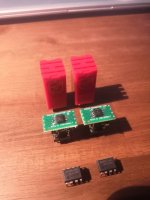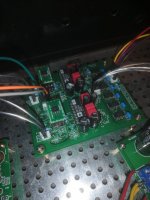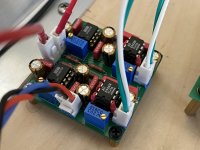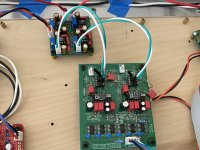Nice work!
Looks like the chips are on their way over the Atlantic in the next day or two, so get busy 🙂
I haven't tried the op amps you have, but did really like the LM6171 and ADA4898 as well. OP627 kept winning the competition, but it was fun. Are you testing in stereo or mono? I didn't think until later to use a mono source and put competing op amps in each channel of the DAC.
Looks like the chips are on their way over the Atlantic in the next day or two, so get busy 🙂
I haven't tried the op amps you have, but did really like the LM6171 and ADA4898 as well. OP627 kept winning the competition, but it was fun. Are you testing in stereo or mono? I didn't think until later to use a mono source and put competing op amps in each channel of the DAC.
an other one ????
AD844 can be tried as we are in a single chip layout and this chip has a buffer.
With two opa861 (the last reversed in buffer conf, the AD844 looses. But alone the AD844 have a buffer output that is internally feedbacked -which makes the opa 861 better than the 860 or the ad844 to make short a longer story- But I really think most doesn't need a buffer with the opa 861 with a normal pre or amp (i.e. no headphones or exotic conf with pre with low input impedance à la 5 or 10k and too much long several meters cables).
Imho the LM is certainly as capable as the ad844. So the list from Galac I advised remains for me the best with the LM and the other ADA4898.
Again it's not easy because I/V & Buffer has to be made in the same chip, hence one of the bunch that could sound better than an other in each particular owner setup. That list is the sota operational amplifiers from nowadays for I/V purpose !
Tgink that the few sota CD players from TEAC or Denon that embeded the ad1862 were running with opa2604... the newest ones are much better...and diyers and enthuiasts worked a lot to make better (ah Jocko Homo said this was the best R2R dac chip ever !!😉)
Of course after there are the discrete diamond à la Rogic, or EUVL... but much more work. Rogic said the opa861 is so much well made than even a discrete will have hard time to make better.. In fact it can if you sort out the parts, do thermal coupling as said EUVL with the design he offered few pages aboves and you can design a 4 layers pcb cause the diamonf config : look at Painkiller project in this forum for more understanding.
AD844 can be tried as we are in a single chip layout and this chip has a buffer.
With two opa861 (the last reversed in buffer conf, the AD844 looses. But alone the AD844 have a buffer output that is internally feedbacked -which makes the opa 861 better than the 860 or the ad844 to make short a longer story- But I really think most doesn't need a buffer with the opa 861 with a normal pre or amp (i.e. no headphones or exotic conf with pre with low input impedance à la 5 or 10k and too much long several meters cables).
Imho the LM is certainly as capable as the ad844. So the list from Galac I advised remains for me the best with the LM and the other ADA4898.
Again it's not easy because I/V & Buffer has to be made in the same chip, hence one of the bunch that could sound better than an other in each particular owner setup. That list is the sota operational amplifiers from nowadays for I/V purpose !
Tgink that the few sota CD players from TEAC or Denon that embeded the ad1862 were running with opa2604... the newest ones are much better...and diyers and enthuiasts worked a lot to make better (ah Jocko Homo said this was the best R2R dac chip ever !!😉)
Of course after there are the discrete diamond à la Rogic, or EUVL... but much more work. Rogic said the opa861 is so much well made than even a discrete will have hard time to make better.. In fact it can if you sort out the parts, do thermal coupling as said EUVL with the design he offered few pages aboves and you can design a 4 layers pcb cause the diamonf config : look at Painkiller project in this forum for more understanding.
Last edited:
Some I/V thoughts Galac
Lots of good info Diyiggy! Funny you should mention the AD844, I recently built the triple stack AD844/OPA627 I/V buffer. I sort of did this backwards as I built the OPA861/OPA861 output stage first. In my opinion both methods sound excellent. I could be happy with either, but the cost to build the Triple Stack AD844/OPA627 is definitely a negative if you had to purchase the parts specifically for this board. I happened to have the opamps in my parts bin already 😀
As for a simple opamp plug in for Miro’s Dac board I find the OPA1656 (properly connected to an adapter pcb) and the OPA627 are very hard to beat in my main system.
Nice setup Galac!
Lots of good info Diyiggy! Funny you should mention the AD844, I recently built the triple stack AD844/OPA627 I/V buffer. I sort of did this backwards as I built the OPA861/OPA861 output stage first. In my opinion both methods sound excellent. I could be happy with either, but the cost to build the Triple Stack AD844/OPA627 is definitely a negative if you had to purchase the parts specifically for this board. I happened to have the opamps in my parts bin already 😀
As for a simple opamp plug in for Miro’s Dac board I find the OPA1656 (properly connected to an adapter pcb) and the OPA627 are very hard to beat in my main system.
Nice setup Galac!
Attachments
Last edited:
[emoji1][emoji1][emoji1][emoji1][emoji6][emoji106]Yes please, more hifi porn for people 🙂
@all
Thanks for your extensive and valuable feedback!
@Paddy
I really like the "mono" idea as I have a switch laying around that switches L (or R) to both channels (which was intended to make cartridge setup easier) and changing the bottom opamp is way more effort.
@diyiggy
Yes, I talked about the "Simple Discrete Current-Mirror IV Converter, à la AD844" from EUVL. But I have to think about the implementation cause I'm somewhat space constrained and didn't intend to route another DAC PCB - for now 😉
@Vunce
As I really don't like the price of the OPA627 I'll give the OPA1656 a shot
Thanks for your extensive and valuable feedback!
@Paddy
I really like the "mono" idea as I have a switch laying around that switches L (or R) to both channels (which was intended to make cartridge setup easier) and changing the bottom opamp is way more effort.
@diyiggy
Yes, I talked about the "Simple Discrete Current-Mirror IV Converter, à la AD844" from EUVL. But I have to think about the implementation cause I'm somewhat space constrained and didn't intend to route another DAC PCB - for now 😉
@Vunce
As I really don't like the price of the OPA627 I'll give the OPA1656 a shot
All built and done, I thought... Can you guys help me troubleshooting? I have literally nothing on the output. To be honest I would not know where to start troubleshooting?
I must confess that I made the mistake of reversing the caps on C32 and C27, because I thought I had an old board... Now I have correctly soldered the caps in again ( I assume as they do not pop as the previous two). Could this have destroyed something in the process of popping?
Your help is much appreciated🙂
I must confess that I made the mistake of reversing the caps on C32 and C27, because I thought I had an old board... Now I have correctly soldered the caps in again ( I assume as they do not pop as the previous two). Could this have destroyed something in the process of popping?
Your help is much appreciated🙂
Best would be to take some good pictures from both sides, without it is just poking in the fog.
Thanks, I replied to soon, I forgot to populate r10 and r11, pfff been a rough week😉... Now we have music!!!!
Let the fun begin🙂🙂 I will post my first impression tomorrow, as it is in the middle of the night here.
View attachment 895227
Let the fun begin🙂🙂 I will post my first impression tomorrow, as it is in the middle of the night here.
View attachment 895227
Last edited:
Let's start with my setup:
- Lm317 psu for 5v digital and fifopi clean side (might need to separate those) from aliexpress
-lt3042 psu for 12v (also from aliexpress)
-audiophonics trafo's
-Salas L'adapter for rpi3
-fifopi with accusilicon clocks
-opamps used: opa810, ne5534, burson v6 vivid.
So far I have tested the opa810 and ne5534, of which I prefer the first. This is only on short listening session so no final conclusions here.
I like it so far, but we are not there yet. The lows are a bit muddy but plenty, and highs can be somewhat shrill and flat.
Compared to my dddac: on the dddac the bass has more details and highs are floating around with more nuances. Bear in mind that this dac has output trafo's of approx USD 300.
I still need to sit down for a while to listen to the Bursons, as I have not heard these yet.
One question I have to you guys: does r11 and r10 resistor do anything to the sound? I have put in 22r but wonder if i should just jumper it? (guess it doesn't matter but confirmation would be nice😉)


- Lm317 psu for 5v digital and fifopi clean side (might need to separate those) from aliexpress
-lt3042 psu for 12v (also from aliexpress)
-audiophonics trafo's
-Salas L'adapter for rpi3
-fifopi with accusilicon clocks
-opamps used: opa810, ne5534, burson v6 vivid.
So far I have tested the opa810 and ne5534, of which I prefer the first. This is only on short listening session so no final conclusions here.
I like it so far, but we are not there yet. The lows are a bit muddy but plenty, and highs can be somewhat shrill and flat.
Compared to my dddac: on the dddac the bass has more details and highs are floating around with more nuances. Bear in mind that this dac has output trafo's of approx USD 300.
I still need to sit down for a while to listen to the Bursons, as I have not heard these yet.
One question I have to you guys: does r11 and r10 resistor do anything to the sound? I have put in 22r but wonder if i should just jumper it? (guess it doesn't matter but confirmation would be nice😉)


Test it with another opamp, like LM6171.
R10,11 itself should not affect the sound. Contains your DDDAC a coupling capacitor on the output? It can enhance the bass color. You can use a similar coupling capacitor instead of R10,11. Anyway if somewhat possible, try it with a decent output transformer.
It would be terrific if this little piece overtake a big NOS project as DDDAC 😀
R10,11 itself should not affect the sound. Contains your DDDAC a coupling capacitor on the output? It can enhance the bass color. You can use a similar coupling capacitor instead of R10,11. Anyway if somewhat possible, try it with a decent output transformer.
It would be terrific if this little piece overtake a big NOS project as DDDAC 😀
Different R2R DAC shootout here
There are Discrete R-2R DAC from Chinese Market, TDA1541 DAC (PCB from Australia) and AD1862 from miro1360 with industrial grade capacitors and resistors (even IV part).
AD1862 is survived amongst these DACs. Seems TDA1541 DAC is with more Mellow mid with forward soundstage. Discrete R-2R DAC is bit more details with a bit backward soundstage. And AD1862 is somewhere on the middle between these 2.
Personally I like AD1862 a little more with its balanced sound and its sound quality. long time listening with it without fatigued
One interesting thing we agreed that the JLsound card did a very good job, even we only use pi2 USB output. But we are just curious that:
1. will it better Sound Quality if using PCM output from JLsound card without 6 onboard shift registers?
2. will it better Sound Quality if using isolator to provide I2S signal between pi2 and AD1862 DAC to skip the USB signal transmission?
If someone have same experience, may kindly express your feel.
There are Discrete R-2R DAC from Chinese Market, TDA1541 DAC (PCB from Australia) and AD1862 from miro1360 with industrial grade capacitors and resistors (even IV part).
AD1862 is survived amongst these DACs. Seems TDA1541 DAC is with more Mellow mid with forward soundstage. Discrete R-2R DAC is bit more details with a bit backward soundstage. And AD1862 is somewhere on the middle between these 2.
Personally I like AD1862 a little more with its balanced sound and its sound quality. long time listening with it without fatigued
One interesting thing we agreed that the JLsound card did a very good job, even we only use pi2 USB output. But we are just curious that:
1. will it better Sound Quality if using PCM output from JLsound card without 6 onboard shift registers?
2. will it better Sound Quality if using isolator to provide I2S signal between pi2 and AD1862 DAC to skip the USB signal transmission?
If someone have same experience, may kindly express your feel.
Last edited:
In the 2, you have to name the i2s device to make a proper benchmark....
You can not compare sound quality of two ic like that. Not the same layout around.
You can not compare sound quality of two ic like that. Not the same layout around.
Last edited:
I have not tried yet these two conf, but if the source is still rpu2 eactime, you will have a little edge with the fifopi. Notice fifopi often uses Crystek and not ndk...different hearing result.
Hard to say one is better...optimisation is the key...piwersupplies, short cables distance...
The best qp by far is the JLsound...imho, tastes and whole setups differ...
Hard to say one is better...optimisation is the key...piwersupplies, short cables distance...
The best qp by far is the JLsound...imho, tastes and whole setups differ...
Hi diyiggy, TDA1541 can give lively music... you are right. Taste is very personally and just get a good setup to enjoy music...
diyiggy, any more tips that can play AD1862 around?
diyiggy, any more tips that can play AD1862 around?
Testing with Bursons now, which is quite a step up already I must confess, would not have expected that much of an improvement!Test it with another opamp, like LM6171.
R10,11 itself should not affect the sound. Contains your DDDAC a coupling capacitor on the output? It can enhance the bass color. You can use a similar coupling capacitor instead of R10,11. Anyway if somewhat possible, try it with a decent output transformer.
It would be terrific if this little piece overtake a big NOS project as DDDAC 😀
No, the Dddac is passive i/v with transformers on the output.
The sound is now very, very enjoyable! Music has been on all day[emoji16]
Now for the tricky part, are the chinese PSU's doing a porper job?? ....
@Robin
AD1862 is very enjoyable, hard to peel off, like a strong music magnet 😀
I mean this coupling capacitor together with 100k resistor:
https://ctrlv.cz/shots/2020/11/21/LuUQ.png
I'm not sure about the PSU. If you have the opportunity, try other power sources.
Can you buy the regulators MC7812/7912, MC7805/7905 from OnSemi? Try them. Filter the PSU input stage with a bank of capacitors (the more the better), for the output stage use only about 22-47uF. You can put it together simply without a PCB, nothing complicated: https://ctrlv.cz/shots/2020/11/21/zscN.png
AD1862 is very enjoyable, hard to peel off, like a strong music magnet 😀
I mean this coupling capacitor together with 100k resistor:
https://ctrlv.cz/shots/2020/11/21/LuUQ.png
I'm not sure about the PSU. If you have the opportunity, try other power sources.
Can you buy the regulators MC7812/7912, MC7805/7905 from OnSemi? Try them. Filter the PSU input stage with a bank of capacitors (the more the better), for the output stage use only about 22-47uF. You can put it together simply without a PCB, nothing complicated: https://ctrlv.cz/shots/2020/11/21/zscN.png
Testing with Bursons now, which is quite a step up already I must confess, would not have expected that much of an improvement!
No, the Dddac is passive i/v with transformers on the output.
The sound is now very, very enjoyable! Music has been on all day[emoji16]
Now for the tricky part, are the chinese PSU's doing a porper job?? ....
Hi Robin,
I have a souped up four board DDDAC with valve output stage which is very, very good. I'd expect to beat that with this design, passive i/v and valve output stage and that's what I'm building. I think you'll find as you are, that the op amp is one of the keym limiters in this implementation. I'll report back when I've got my chips and completed the build.
David
- Home
- Source & Line
- Digital Line Level
- DAC AD1862: Almost THT, I2S input, NOS, R-2R


